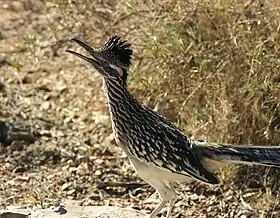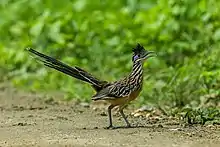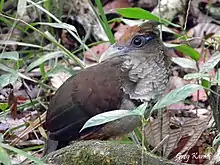| Neomorphinae Temporal range: Early Oligocene to recent | |
|---|---|
 | |
| Greater roadrunner (Geococcyx californianus) | |
| Scientific classification | |
| Domain: | Eukaryota |
| Kingdom: | Animalia |
| Phylum: | Chordata |
| Class: | Aves |
| Order: | Cuculiformes |
| Family: | Cuculidae |
| Subfamily: | Neomorphinae Shelley, 1891 |
| Genera | |
The Neomorphinae are a subfamily of the cuckoo family, Cuculidae. Members of this subfamily are known as New World ground cuckoos, since most are largely terrestrial and native to the Americas.[1] Only Dromococcyx and Tapera are more arboreal, and these are also the only brood parasitic cuckoos in the Americas, while the remaining all build their own nests.
Genera
| Image | Genus | Living Species |
|---|---|---|
 | Dromococcyx Wied-Neuwied, 1832 |
|
 | Geococcyx Wagler, 1831 |
|
.jpg.webp) | Morococcyx P.L. Sclater, 1862 |
|
 | Neomorphus Gloger, 1827 |
|
.jpg.webp) | Tapera Thunberg, 1819 |
|
References
- ↑ Myers, P. R.; Parr, C. S.; Jones, T.; Hammond, G. S.; Dewey, T. A. "Neomorphinae (New World ground cuckoos)". Animal Diversity Web. University of Michigan. Retrieved 2009-08-12.
This article is issued from Wikipedia. The text is licensed under Creative Commons - Attribution - Sharealike. Additional terms may apply for the media files.